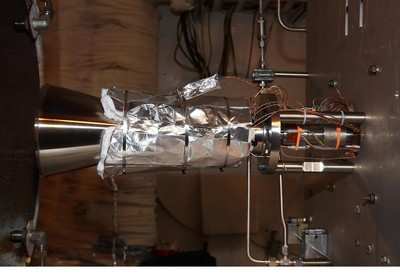Wed, Apr 21, 2010
Aerojet Completes Second Series Of Vibration And Hot Fire Risk
Reduction Engine Tests
Aerojet has successfully completed a second series of vibration
and altitude hot-fire tests on its 160-pound thrust mono-propellant
rocket engine planned for use on NASA's Orion spacecraft. Aerojet
is providing all of the engines for Orion's crew and service
modules for Lockheed Martin.

File Photo
The objective of the test program was
to characterize further engine performance after the thruster was
subjected to Orion crew module vibration loads which are higher
than the engine had been previously tested. Vibration loads applied
to the thruster produced energy levels that were three times the
previously qualified levels, signifying the engine's robust design
capability to withstand substantially higher vibration loads. The
post-vibration altitude hot-fire test sequences mapped the thruster
health over its full operating range ensuring that the engine meets
its mission performance requirements after being subjected to Orion
vibration loads during launch.
The hot-fire test program fully demonstrated the capability to
reach at least 175 pounds of thrust during steady-state firing,
thereby showing an Orion contingency operation during an abort
mission. The firing sequences included 40 millisec. and 120
millisec. pulse mode tests as well as steady-state firings of five
seconds and longer, to demonstrate engine performance health. The
first firing sequence was a seven second steady-state firing at a
feed pressure matching the maximum expected operating pressure
(MEOP) with the thruster at ambient temperature to ensure the test
sequence started at all possible firing conditions following an
abort.
The testing met all objectives, providing additional confidence
that Orion's crew module engine will meet all applicable
performance requirements after being subjected to Orion abort
vibration loads. "This recent testing helps close an identified
risk and provides confidence that Aerojet's MR-104 design for Orion
meets or exceeds the abort mission requirements," said Doug Cosens,
Aerojet's Orion program director. "This effort also illustrates
continued excellent cooperation among Aerojet, Lockheed Martin and
NASA on the Orion project."

The current Orion crew module flight configuration includes 12
MR-104G engines operating at 160 pounds of thrust. The MR-104
engine family originally provided in-space propulsion for the
Voyager 1 and 2 and Magellan missions, and subsequent MR-104
variants provided propulsion for Landsat and NOAA as well as other
U.S. government programs.
Aerojet is part of the nationwide Orion industry team led by
Lockheed Martin, which also includes five major subcontractors and
an expansive network of minor subcontractors and small businesses
working at 88 facilities in 28 states across the country.
More News
Circle To Runway (Runway Number) Used by ATC to inform the pilot that he/she must circle to land because the runway in use is other than the runway aligned with the instrument appr>[...]
Aero Linx: National Aviation Safety Foundation (NASF) The National Aviation Safety Foundation is a support group whose objective is to enhance aviation safety through educational p>[...]
At Altitude Of About 250-300 Ft Agl, The Airplane Experienced A Total Loss Of Engine Power On November 6, 2024, at 1600 central standard time, a De Havilland DHC-1, N420TD, was inv>[...]
From 2009 (YouTube Edition): Three Hour Flight Was 'Flawless' -- At Least, Until Mother Nature Intervened For anyone who loves the aviation business, this was a VERY good day. Afte>[...]
Also: AMA Names Tyler Dobbs, More Falcon 9 Ops, Firefly Launch Unsuccessful, Autonomous F-16s The Air Force has begun ground testing a future uncrewed jet design in a milestone tow>[...]
 ANN's Daily Aero-Term (05.05.25): Circle To Runway (Runway Number)
ANN's Daily Aero-Term (05.05.25): Circle To Runway (Runway Number) ANN's Daily Aero-Linx (05.05.25)
ANN's Daily Aero-Linx (05.05.25) NTSB Prelim: De Havilland DHC-1
NTSB Prelim: De Havilland DHC-1 Classic Aero-TV: The Boeing Dreamliner -- Historic First Flight Coverage
Classic Aero-TV: The Boeing Dreamliner -- Historic First Flight Coverage Airborne-NextGen 05.06.25: AF Uncrewed Fighters, Drones v Planes, Joby Crew Test
Airborne-NextGen 05.06.25: AF Uncrewed Fighters, Drones v Planes, Joby Crew Test



